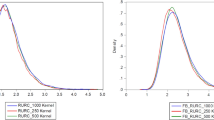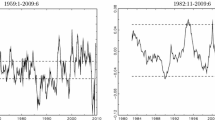Abstract
This paper investigates the influence of heteroskedastic variances on cointegration tests. The Monte Carlo simulation results show that cointegration tests allowing for threshold adjustments or structural breaks overreject the null hypothesis of no cointegration in the presence of GARCH errors and variance breaks. In particular, multivariate GARCH and bivariate variance breaks cause severe size distortions in such cointegration tests. On the other hand, a variance ratio cointegration test yields reasonable empirical sizes under most cases of heteroskedastic variances, as compared to other tests including standard cointegration tests.
Similar content being viewed by others
References
Baillie RT, Morana C (2009) Modelling long memory and structural breaks in conditional variances: an adaptive FIGARCH approach. J Econ Dyn Control 33: 1577–1592
Bauwens L, Laurent S, Rombouts JVK (2006) Multivariate GARCH models: a survey. J Appl Economet 21: 79–109
Bollerslev T, Mikkelsen HO (1996) Modelling and pricing long memory in stock market volatility. J Economet 73: 151–184
Breitung J (2002) Nonparametric tests for unit roots and cointegration. J Economet 108: 343–363
Brunetti C, Gilbert CL (2000) Bivariate FIGARCH and fractional cointegration. J Empir Finance 7: 509–530
Busetti F, Taylor AMR (2003) Variance shifts, structural breaks, and stationarity tests. J Bus Econ Stat 21: 510–531
Cavaliere G, Taylor AMR (2006) Testing the null of co-integration in the presence of variance breaks. J Time Ser Anal 27: 613–636
Cavaliere G, Rahbek A, Taylor AMR (2010) Testing for co-integration in vector autoregressions with non-stationary volatility. J Economet 158: 7–24
Chou RY (1988) Volatility persistence and stock valuations: Some empirical evidence using GARCH. J Appl Economet 3: 279–294
Cook S (2006) Testing for cointegration in the presence of mis-specified structural change. Stat Probab Lett 76: 1380–1384
Enders W, Ludlow J, (2002) Tests for nonlinear decay using a Fourier approximation, Working paper, Department of Economics, Finance and Legal Studies, The University of Alabama
Enders W, Siklos PL (2001) Cointegration and threshold adjustment. J Bus Econ Stat 19: 166–176
Engle RR, Granger CWJ (1987) Cointegration and error correction: Representation, estimation and testing. Econometrica 55: 251–276
Ewing BT, Payne JE, Thompson MA, Al-Zoubi OM (2006) Government expenditure and revenues : Evidence from asymmetric modeling. South Econ J 73: 190–200
Franses PH, Kofman P, Moser J (1994) Garch effects on a test of cointegration. Rev Quant Finance Account 4: 19–26
Ghoshray A (2010) Smooth transition effects in price transmission: The case of international wheat export pricesstar. Econ Lett 106: 169–171
Gregory AW, Hansen BE (1996) Residual-based tests for cointegration in models with regime shifts. J Economet 70: 99–126
Harris D., McCabe B., Leybourne S (2002) Stochastic cointegration: estimation and inference. J Economet 111: 363–384
Hatemi JA (2008) Tests for cointegration with two unknown regime shifts with an application to financial market integration. Empir Econ 35: 497–505
Hatemi JA, Roca E (2010) A re-examination of the unbiased forward rate hypothesis in the presence of multiple unknown structural breaks. Appl Econ (forthcoming)
Höglund R, R (2003) Size and power of some cointegration tests under structural breaks and heteroskedastic noise. Stat Papers 44: 1–22
Johansen S (1988) Statistical analysis of cointegration vectors. J Econ Dyn Control 12: 231–254
Johansen S (1991) Estimation and hypothesis testing of cointegration vectors in Gaussian vector autoregressive models. Econometrica 59: 1551–1580
Kapetanios G, Shin Y, Snell A (2006) Testing for cointegration in nonlinear smooth transition error correction models. Economet Theory 22: 279–303
Kasman A (2008) Foreign exchange reserves and exchange rates in Turkey: structural breaks, unit roots and cointegration. Econ Model 25: 83–92
Lee TH, Tse Y (1996) Cointegration tests with conditional heteroskedasticity. J Economet 73: 401–410
Lütkepohl H, Saikkonen P, Trenkler C (2001) Maximum eigenvalue versus trace tests for the cointegrating rank of a VAR process. Economet J 4: 287–310
Maheu J (2005) Can GARCH models capture long-range dependence?. Stud Nonlin Dyn Economet 9: 1–41
Maki D (2006) Nonlinear adjustment in the term structure of interest rates: a cointegration analysis in the nonlinear STAR framework. Appl Financ Econ 16: 1301–1307
Maki D, Kitasaka S (2006) The equilibrium relationship among money, income, prices, and interest rates: evidence from a threshold cointegration test. Appl Econ 38: 1585–1592
McMillan DG (2008) Non-linear cointegration and adjustment: an asymmetric exponential smooth-transition model for US interest rates. Empir Econ 35: 591–606
Pavlidis E, Paya I, Peel D (2010) Specifying smooth transition regression models in the presence of conditional heteroskedasticity of unknown form. Stud Nonlin Dyn Economet 14(3) Article 3, 1–40
Sensier M, van Dijk D (2004) Testing for volatility changes in U.S. macroeconomic time series. Rev Econ Stat 86: 833–839
van Dijk D, Franses PH, Lucas A (1999) Testing for smooth transition nonlinearity in the presence of outliers. J Bus Econ Stat 17: 217–235
van Dijk D, Franses PH, Lucas A (1999) Testing for ARCH in the presence of additive outliers. J Appl Economet 14: 539–562
Author information
Authors and Affiliations
Corresponding author
Rights and permissions
About this article
Cite this article
Maki, D. The influence of heteroskedastic variances on cointegration tests: A comparison using Monte Carlo simulations. Comput Stat 28, 179–198 (2013). https://doi.org/10.1007/s00180-011-0293-x
Received:
Accepted:
Published:
Issue Date:
DOI: https://doi.org/10.1007/s00180-011-0293-x




